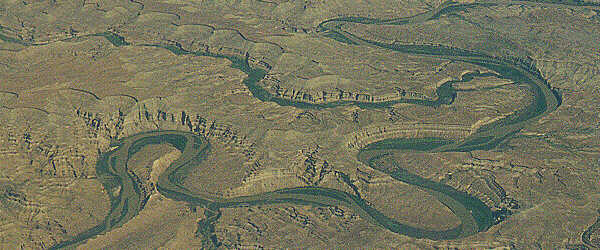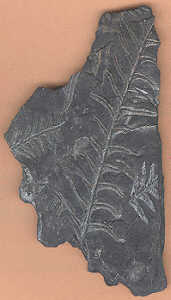Early Models of Evolution
Very Brief Summary of Babylonian and Egyptian Views

Ancient View of the Earth
The Babylonian and Egyptian “creation” stories both include the idea of a
primordial sea from which the Earth and life arose. These stories often
included the idea of humans being born from a goddess.
The primeval Chaos was a “god” who created people and nature and the other
gods.
In some Mediterranean and/or northern European civilizations,
some of the widely-accepted
theories of the universe had the Earth as a flat disk floating on the world
ocean which surrounded it. Below was water (forever?) and above was sky,
the abode of the gods. The land portion included all that was known at the
time, basically an area around the Mediterranean Sea. “Down” (somewhere
under the world ocean?) was the underworld. What people were able to
observe in their daily lives was an universal frame of reference. Obviously,
if the Earth was round, any people, water, etc. on the bottom would fall
off.
Early Greek Philosophers
The Greek philosophers were perhaps the first to separate the
question of origins from their gods and goddesses. The Greeks believed that
the gods and goddesses, too, were created out of the primordial substance(s).
Greek thought went one step farther. They thought of air or water as the
first cause of all life (both their gods and humans). These were not an
air-god or water-god, and the gods (who were also created) did not create
nature nor humans. The gods and humans both came from
Gaia,
mother Earth, who was not one of the gods on Mt. Olympus, but some sort of a
predecessor to everything.
Among the Greek philosopers were:
- Thales (650 - 580 BC) regarded water as the cause, beginning, and end of
all things. His ideas were probably the beginning of the controversy among
the Greek philosophers regarding the importance of water vs. air vs. fire as
the “primordial substance.”
- Anaximander
(611 - 546 BC) is credited with the first written work on natural science, a
classical poem entitled On Nature. In this poem, he presented what
may be the first written theory of
evolution.
He wrote that animals arose from slime which had been evaporated by the sun.
He thought that the first animals lived in the sea and had prickly, scaly
coverings. As these fish-like creatures evolved, they moved onto land,
shed their scaly coverings, and became humans.
- Heraclitus (around the same time) felt that the universe is continually
changing, thus it is senseless to ask for its origins in the manner of a
myth. He taught that there is no beginning or end, only existence.
- Xenophanes
(b. 570 BC) was one of the first people to observe
fossils
in rock layers. Interestingly, he recognized that the rock in which the
fossils were found had at one time been submerged mud. He explained the
existance of fossils by saying that that the world evolved from a mixture of
earth and water, and that the Earth will gradually be re-dissolved. He
believed that the Earth has gone through this cycle several times leading up
to the visible fossils.
Later Greek Philosophers
- Empedocles
(~490 - ~440 BC) tried to solve the water-earth-fire debate by saying that
there were not one nor two, but four original elements: Earth, Air, Fire,
and Water. He thought that everything else came about through their
combination and/or separation by the two opposite principles of Love and
Strife.
-

Earth, Air, Fire, and Water
- Among the many things for which
Plato
(427 - 343 BC) is remembered is his idea that there were two worlds. He said
the world which we see is just an illusion, evil, an imperfect copy of the
real world, transitory, and will decay. The real world which we cannot see
because it’s invisible, is good, perfect, eternal, and static or unchanging.
In the real world, there is obviously no variation or change, nor need for
any, because all the organisms there are perfect. The variation we see
among organisms here is because they are imperfect copies of the real
“types” in the real world. This “pagan” idea was borrowed and incorporated
into Christian beliefs, and in sharp contrast to the Jewish belief that we
are caretakers of the Earth, has been used to justify our wanton trashing
of the planet (“Who cares, since it’s evil and temporary, anyway”).
- Aristotle
(384 - 322 BC), one of Plato’s most famous pupils, said that species are
fixed in a hierarchy from simplest to most complex, like rungs on a ladder
(the
Scala naturae)
with no vacancies, no mobility, and no change/evolution possible since all
the spots were full. Later, these thoughts were incorporated into Christian
views, along with the Hebrew idea that life is created. This view has
dominated Western thought for about 2000 years.
Hebrews (Influenced by Mesopotamians and Egyptians)
The Hebrew people lived in between the Babylonians
(Mesopotamians)
and the Egyptains, and based much of their thoughts and knowledge on the
influence of their neighbors to either side. In many respects, their
creation story is similar to those of their neighbors, especially the
Babylonians, but their God pre-existed before was separate from the primeval
chaos, and he created both nature and people.
1700s through Early- and Mid-1800s
In more recent times, Georges Buffon (mid-1700s) was a
Frenchman who studied
fossils,
and was among the first to suggest the Earth is older than 6000 years.

Water-Eroded Gorge of Green River, E. Utah
James Hutton
(1726 - 1797) published a paper in 1795 (which was later refined/modified by
Charles Lyell)
in which he said that land forms can be accounted for by current mechanisms;
for example, a gorge was cut by the river running through it,
and was not always there. From this, he drew two conclusions:
- slow,
subtle, continuous change over a long time has a profound effect, and
- if
geological
change comes from this slow process, then the Earth is very old, much older
than Archbishop Ussher said.
Needless to say, this sparked much controversy because it was
a challenge to the prevalent theory on the age of the Earth, where we came
from (a challenge to the Christian Church’s interpretation of the book of
Genesis), etc. This was a major challenge to the authority of the Christian
Church and the beginnings of our modern-day split between religion and
science (objective vs. subjective thought).

Fern Fossil in Coal
Rev. Thomas Malthus
(publ 1798), a British sociologist, looked at conditions in the poor
neighborhoods of London. He said that in humans, the problems of disease,
suffering, starvation etc. were a consequence of the potential for the human
population to grow faster than technology could keep up with. Things like
the supplies of food, medical care, etc. were limited in comparison to the
size of the population, thus there was competition for available
resources and only the strong and healthy would survive. He was, thus,
the first to talk about survival of the fittest.
William “Strata” Smith
(1769 - 1839), an English surveyor, was the first to scientifically study
the distribution of fossils. He studied the order of rock
strata
or layers and noted that the same strata in different areas of England
contained the same fossils. He found he could actually use the fossils in
the various strata as indicators of which rock layer he was examining.

Lamarckian Evolution
Jean Baptiste Lamarck
(publ 1802 or 1809) developed a theory of evolution in which the main points
were:
- evolution
or change within a species is driven by an innate, inner striving toward
greater perfection,
- use or
disuse of various organs made them larger or smaller, accordingly, and
- these
acquired traits could be inherited or passed on to offspring (inheritance of
acquired traits).
A number of subsequent attempts were
made to prove or disprove this theory without the benefit of our modern
knowledge of genetics. One experiment involved amputation of mouse tails
for successive generations, showing that even after twenty generations,
there was no effect: baby mice were still born with tails. The Jewish
practice of circumcision was also cited as opposing evidence, since obviously
it had caused no long-lasting change in the population and still needed to be
done to each new boy baby. Lamarck’s theory seemed to make sense in the
light of the then-accepted theory of pangenes coming from the body parts to
make up the homunculus. The classic example he used was giraffes. He felt
that giraffes’ necks got longer because they stretched to reach higher
leaves, and this was passed on to their babies. Another example, to make
the fallacy of his theory more apparent, would be two people who developed
large arm muscles because they were blacksmiths, tennis players, or
weight-lifters having a baby who was born with larger than normal arm
muscles.
Late-1800s through Mid-1900s
Louis Pasteur
(publ 1860) disproved spontaneous generation for smaller organisms (bacteria).
Up until this time, people thought that bacteria and other microscopic
organisms could just come into existance from changes in the external
environment. Pasteur’s experiment with flasks with straight vs. curved
(swan-neck) flasks showed that for bacteria to grow in a sterile medium,
their ancestors must first “fall” into the medium from somewhere else
(there are many bacteria afloat in the air around us).
Charles Darwin
published the Origin of Species in 1859. His theories and where they
have led will be discussed in a subsequent class period.
Alexander Ivanovich Oparin
(publ 1936), a Russian scientist, in The Origins of Life, described
hypothetical conditions which he felt would have been necessary for life to
first come into existence on early Earth. He thought the atmosphere was
made largely of methane, ammonia, etc. and that there was much more volcanic
activity and lightening than now. This theory was later tested by an
experiment done by
Stanley Miller
as a grad student under Harold Urey in 1953. This experiment will be
covered in greater depth in a subsequent discussion.
Copyright © 1997 by J. Stein Carter. All rights reserved.
This page has been accessed  times since 15 Mar 2001.
times since 15 Mar 2001.




